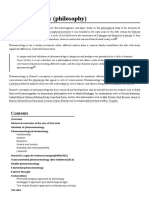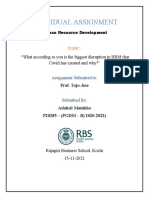0 ratings0% found this document useful (0 votes)
3 viewsPhilosophy
Philosophy
Uploaded by
bhoyetmagcawasCopyright:
© All Rights Reserved
Available Formats
Download as PPTX, PDF, TXT or read online from Scribd
Philosophy
Philosophy
Uploaded by
bhoyetmagcawas0 ratings0% found this document useful (0 votes)
3 views19 pagesCopyright
© © All Rights Reserved
Available Formats
PPTX, PDF, TXT or read online from Scribd
Share this document
Did you find this document useful?
Is this content inappropriate?
Copyright:
© All Rights Reserved
Available Formats
Download as PPTX, PDF, TXT or read online from Scribd
Download as pptx, pdf, or txt
0 ratings0% found this document useful (0 votes)
3 views19 pagesPhilosophy
Philosophy
Uploaded by
bhoyetmagcawasCopyright:
© All Rights Reserved
Available Formats
Download as PPTX, PDF, TXT or read online from Scribd
Download as pptx, pdf, or txt
You are on page 1of 19
UNSCRAMBLED LETTERS
• LWKEDNGO- it is a mental grasp of reality based on perceptual observation.
• EGLYEIOSPTMO- this is a science devoted to the discovery of the proper method
of acquiring and validating knowledge.
• NCPTEOC- it is an abstract or generic idea generalized from particular instances.
• RUTHT- this knowledge is validated which means that is highly based on the facts
of reality.
• NTGRUAEM- a group of statements, one or more which is claimed to provide
support for, or reason to believe one of the others.
ANSWERS
• KNOWLEDGE
• EPISTEMOLOGY
• CONCEPT
• TRUTH
• ARGUMENT
METHODS OF PHILOSOPIZING
• Here we are going to explore some of the
methods of philosophizing that philosophers
employ. According to Wilber (2006) Think of
wisdom as the summit of the mountain with
different paths to get there. We are going to study
the different paths to wisdom the philosophers
offer.
THE DIALECTIC
METHOD
SOCRATIC DIALECTIC METHOD
- Socrates, a Greek philosopher,
developed the dialectic method, a form of
disciplined conversation aimed at
achieving a clear understanding of
concepts, particularly moral concepts like
justice.
- Socrates believed that the soul (psyche)
is made good through knowledge, and this
knowledge is gained by understanding the
true meaning of words.
- The method involves Socrates asking questions to
expose the contradictions in a person’s understanding,
leading them to correct their own errors and arrive at a
clearer understanding.
- This approach, however, was not well-received by the
ruling elites of Athens, leading to Socrates’ trial and
eventual death by poison.
HEGELIAN DIALECTIC METHOD
- German philosopher George Wilhelm Hegel
modernized the dialectic method, focusing on how
ideas evolve within a society.
- Hegel believed that people’s minds are influenced
by the collective consciousness of society, which he
called the “Spirit.”
- The Spirit evolves through a dialectical process
where an idea (thesis) encounters its opposite
(antithesis), and their conflict is resolved by forming a
new idea (synthesis), which incorporates elements of
both.
PRAGMATIC
METHOD
Pragmatism, a philosophy that emerged in
19th century America, was influenced by
the evolutionary ideas of Hegel and
Darwin. Founded by Charles S. Pierce
and popularized by William James and
John Dewey, pragmatism focuses on
making philosophy relevant by solving
real-life problems rather than offering a
set of beliefs.
Pragmatists emphasize that the truth of ideas should be
tested by their practical results. The core principle is that
if a belief leads to successful outcomes and solves
problems, it is considered true. This approach makes
pragmatism a philosophy of method rather than
substance.
PHENOMENOLOGICAL
METHOD
The phenomenological method,
developed by Edmund Husserl in the
19th century, was a response to the
dominance of naturalism, the belief that
everything can be explained in terms of
the physical world. Husserl argued that
this perspective neglects the spiritual
aspects of human existence, leading to a
distorted view of humanity.
To counter this, Husserl emphasized the importance of
returning to “immediate experience”—the world as it
appears to us. He sought to build a philosophy free from
biases and preconceived ideas, focusing on pure
subjectivity. This process, called phenomenological
epoche or bracketing, involves setting aside our biases
to see the world as it truly is through direct experience.
THE PRIMARY AND
SECONDARY REFLECTIONS
Existentialism, rooted in the ideas of
Søren Kierkegaard and Friedrich
Nietzsche, emphasizes the personal
choices of the individual. In the 20th
century, Jean-Paul Sartre and Simone de
Beauvoir popularized atheistic
existentialism, while Gabriel Marcel and
Karl Jaspers promoted religious
existentialism.
Gabriel Marcel introduced the concept of primary
and secondary reflection. Primary reflection occurs
when we analyze and distinguish the self from
objects, such as when filling out a form with
personal details. However, this level of reflection
feels incomplete, as it doesn’t fully capture who we
are.
Secondary reflection goes deeper, questioning the
process of thinking itself and leading to a more
expansive view of the self, ultimately uniting the self
with the world.
THE ANALYTIC
METHOD
The analytic method, developed by philosophers at
Cambridge University like G.E. Moore, Bertrand
Russell, and Ludwig Wittgenstein, focuses on
clarifying the use of language in philosophy rather
than creating new systems of ideas.
Wittgenstein initially viewed language as a way to
state facts, as reflected in his early work Tractatus
Logico-Philosophicus. However, he later
recognized that words have multiple functions
depending on context. He compared words to tools
in a toolbox, each serving different purposes.
Wittgenstein emphasized analyzing how language is
used in ordinary situations, not constructing an ideal
language. He introduced the concept of “language
games,” where the meaning and use of words are
governed by specific rules, similar to rules in a game,
and these rules vary depending on the context, such as
in economics versus everyday life.
You might also like
- Hermeneutics NotesDocument5 pagesHermeneutics Notesthristy100% (3)
- By Manuel B.Dy, JR.: Existentialism and Man'S Search For MeaningDocument5 pagesBy Manuel B.Dy, JR.: Existentialism and Man'S Search For MeaningPauline BiancaNo ratings yet
- RationalismDocument25 pagesRationalismronanjosephd100% (1)
- Scratch Radio Committee Job Descriptions April 2011Document5 pagesScratch Radio Committee Job Descriptions April 2011benstones1No ratings yet
- Latest English Language Yearly Plan Year 6Document21 pagesLatest English Language Yearly Plan Year 6sasauball100% (1)
- 2.2 Mathods of PhilosophizingDocument28 pages2.2 Mathods of PhilosophizingBeatrize TrouvaNo ratings yet
- Module 2.2Document23 pagesModule 2.2Jomarie PauleNo ratings yet
- Philo Lesson 3Document3 pagesPhilo Lesson 3shenieleybmonticod2006No ratings yet
- Week 7 Methods of PhilosophizingDocument8 pagesWeek 7 Methods of PhilosophizingMARIA MENIE RACHONo ratings yet
- Lesson3 in The PhilosophyDocument3 pagesLesson3 in The PhilosophyEden GorraNo ratings yet
- Methods of PhilosophizingDocument10 pagesMethods of Philosophizing3542seyseyNo ratings yet
- Essy 12345678Document7 pagesEssy 12345678eleni ibiiNo ratings yet
- PHILOSOPHYDocument6 pagesPHILOSOPHYmakenNo ratings yet
- Methods of Philosophizing: Jenny Lou Maullon - Guansing Teacher, San Luis Senior High SchoolDocument214 pagesMethods of Philosophizing: Jenny Lou Maullon - Guansing Teacher, San Luis Senior High SchoolCathleen AndalNo ratings yet
- Contemporary PhilDocument10 pagesContemporary PhilAmuja Beauty100% (1)
- 8.MODULE 18 HERMENEUTICAL PHENoMeNOLOGYDocument40 pages8.MODULE 18 HERMENEUTICAL PHENoMeNOLOGYMaRvz Nonat MontelibanoNo ratings yet
- By: Dilshad Hussain ShahDocument12 pagesBy: Dilshad Hussain ShahDilshad ShahNo ratings yet
- Phenomenology - PPT 29-01-2012Document13 pagesPhenomenology - PPT 29-01-2012Dilshad ShahNo ratings yet
- Knowledge Production in Social Sciences - 221014 - 121103Document9 pagesKnowledge Production in Social Sciences - 221014 - 121103The Will of the NightNo ratings yet
- Methods of Philosophizing Final 2Document7 pagesMethods of Philosophizing Final 2K's Music PhNo ratings yet
- Response To Pp. 243-281 Intro To PhilosophyDocument1 pageResponse To Pp. 243-281 Intro To PhilosophyPayton RothNo ratings yet
- PhenomenologyDocument14 pagesPhenomenologyBrandon McguireNo ratings yet
- Typing Project PDFDocument20 pagesTyping Project PDFUzair Ahmed KhanNo ratings yet
- Modern Philosophy: o o o o o o o oDocument6 pagesModern Philosophy: o o o o o o o orizabesmonteNo ratings yet
- Suggests How To Move A Step Closer Toward Such A Unified Integral UnderstandingDocument5 pagesSuggests How To Move A Step Closer Toward Such A Unified Integral Understandingbanshan466No ratings yet
- Three Pillars of Phenomenology - Husserl, Heidegger and Merlau-PontyDocument9 pagesThree Pillars of Phenomenology - Husserl, Heidegger and Merlau-Pontyytcprkmz7gNo ratings yet
- Methods of PhilosophizingDocument2 pagesMethods of PhilosophizingEuniceCareLanaja100% (1)
- Week2 Methods of PhilosophizingDocument20 pagesWeek2 Methods of Philosophizingmargaretisabel16No ratings yet
- Differentiate The Different Methods of Philosophizing in Determining or Distinguishing Opinion and TruthDocument2 pagesDifferentiate The Different Methods of Philosophizing in Determining or Distinguishing Opinion and TruthRowena Diaz Dela CruzNo ratings yet
- Philo Lesson 3Document7 pagesPhilo Lesson 3Gelika CruzNo ratings yet
- Phenomenology Presentation Sister Olive and SaraDocument27 pagesPhenomenology Presentation Sister Olive and Saraapi-257674266No ratings yet
- Phenomenology - What Is It? and What Does It Do?Document10 pagesPhenomenology - What Is It? and What Does It Do?samuryaNo ratings yet
- PragmatistDocument30 pagesPragmatistTita SomantriNo ratings yet
- 6 (D) StructuralismDocument11 pages6 (D) StructuralismKaushal SinghNo ratings yet
- Philosophy Task 6Document6 pagesPhilosophy Task 6miaburgener123No ratings yet
- The Proposal of PragmatismDocument13 pagesThe Proposal of PragmatismebruklcnNo ratings yet
- Sean Kelly - Transpersonal Psychology and The Paradigm of ComplexityDocument11 pagesSean Kelly - Transpersonal Psychology and The Paradigm of ComplexitySmeu-Mare ViorelNo ratings yet
- PhenomenologyDocument31 pagesPhenomenologySaswati ChandaNo ratings yet
- Phenomenological ResearchDocument1 pagePhenomenological ResearchIlika Guha MajumdarNo ratings yet
- Lesson 7 Methods of Philosophizing Hand OutsDocument15 pagesLesson 7 Methods of Philosophizing Hand Outsveuxkasslin3No ratings yet
- Cognitive PsychologyDocument20 pagesCognitive Psychologybonigala.jaanviNo ratings yet
- 10.1. How Do We Acquire Knowledge?Document5 pages10.1. How Do We Acquire Knowledge?HIJRANA RanaNo ratings yet
- Lesson 2 PhilosophyDocument22 pagesLesson 2 PhilosophyMichelle Calera BocbocNo ratings yet
- PragmatismDocument15 pagesPragmatismmriamariiaNo ratings yet
- PhenomenologyDocument31 pagesPhenomenologyMoses Mwah MurayaNo ratings yet
- IdealismDocument5 pagesIdealismOscar MasindeNo ratings yet
- Method of Philosophizing-Group 2Document95 pagesMethod of Philosophizing-Group 2angelene keith castilloNo ratings yet
- Contemporary Philosophy: Introduction To PhenomenologyDocument51 pagesContemporary Philosophy: Introduction To PhenomenologyJosenia ConstantinoNo ratings yet
- Lesson 2: Methods of Philosophizing: Prepared By: Marilyn R. CalderonDocument56 pagesLesson 2: Methods of Philosophizing: Prepared By: Marilyn R. CalderonSophia San Juan100% (1)
- Constructing Realities: An Art of Lenses: 44 Summer ST., North Amherst MA 01059Document8 pagesConstructing Realities: An Art of Lenses: 44 Summer ST., North Amherst MA 01059Betzi RuizNo ratings yet
- 1003C OutlineDocument55 pages1003C Outlinesjpaul045No ratings yet
- Lesson 2Document104 pagesLesson 2Hershey Nicole Nazareno ReginioNo ratings yet
- Handouts in w3 - Intro To PhiloDocument4 pagesHandouts in w3 - Intro To PhiloAnn Shirley BenitezNo ratings yet
- Methods of Philosophizing 1. The Dialectic MethodDocument2 pagesMethods of Philosophizing 1. The Dialectic MethodZymer TarreNo ratings yet
- Phenomenological Psychology Note 3Document12 pagesPhenomenological Psychology Note 3dinsha3No ratings yet
- Lesson 1 - The Self From Various PerspectiveDocument6 pagesLesson 1 - The Self From Various PerspectivePaige PHNo ratings yet
- Comprehensive ReportDocument10 pagesComprehensive ReportAbby OjalesNo ratings yet
- ExistentialismDocument4 pagesExistentialismOmar AdilNo ratings yet
- A List of Philosophical Schools of ThoughtDocument17 pagesA List of Philosophical Schools of ThoughtRACQUEL DELOS SANTOSNo ratings yet
- Psicología General-Semana 1Document12 pagesPsicología General-Semana 1FRANKLIN AVILA PAREJANo ratings yet
- Philosophical Foundations: Ontology, Epistemology and Research ParadigmsDocument19 pagesPhilosophical Foundations: Ontology, Epistemology and Research ParadigmsIshmam Mohammad AdnanNo ratings yet
- Psychology: From Spirits to Psychotherapy: the Mind through the AgesFrom EverandPsychology: From Spirits to Psychotherapy: the Mind through the AgesNo ratings yet
- Anosha NangrajDocument5 pagesAnosha NangrajAnoshaNo ratings yet
- Bivariate Analysis PDFDocument12 pagesBivariate Analysis PDFHygienix FsdNo ratings yet
- Gaurang - Reportory LectureDocument42 pagesGaurang - Reportory LectureJayakrishnaNo ratings yet
- HRD Individual Assignment (P20285)Document4 pagesHRD Individual Assignment (P20285)Manikho KaibiNo ratings yet
- Post Post-Feminism Gill Roxane Gay PairingDocument22 pagesPost Post-Feminism Gill Roxane Gay PairingJuliana RamosNo ratings yet
- Foundations of PlanningDocument19 pagesFoundations of PlanningAkiNiHandiongNo ratings yet
- 1.2 Energetics and Enthalpy Changes RescuedDocument18 pages1.2 Energetics and Enthalpy Changes RescuedIsamElAminNo ratings yet
- 11 - Ip - Practical List2023-24Document2 pages11 - Ip - Practical List2023-24Vivek ChoudharyNo ratings yet
- CC SPW 01000 02Document34 pagesCC SPW 01000 02kandy saidNo ratings yet
- Improw C SequstDocument2 pagesImprow C Sequst882520340No ratings yet
- Penny: Pull-AlongDocument17 pagesPenny: Pull-AlongMauro RegisNo ratings yet
- Peterson Practice Test 2 SatDocument46 pagesPeterson Practice Test 2 SatAiko EugeniaNo ratings yet
- AbbreviationDocument5 pagesAbbreviationdiane rose lagocNo ratings yet
- Management Accounting: BY - Aprajita Malhan (32) Bharti Singh (44) (Mba - A)Document25 pagesManagement Accounting: BY - Aprajita Malhan (32) Bharti Singh (44) (Mba - A)Jennifer HerreraNo ratings yet
- Joe Orton and The Redefinition of Farce (By Joan F Dean)Document13 pagesJoe Orton and The Redefinition of Farce (By Joan F Dean)Nora LerubNo ratings yet
- Emotions Detection From Messages Using Machine Learning: AbstractDocument4 pagesEmotions Detection From Messages Using Machine Learning: Abstractbipeji9883No ratings yet
- Thyristor or Silicon Controlled Rectifier TutorialDocument7 pagesThyristor or Silicon Controlled Rectifier Tutorialmarcoms75No ratings yet
- Human Relation TheoriesDocument4 pagesHuman Relation TheoriesAlonkrita BoseNo ratings yet
- 2013 Gum - Kondagogu - Rview - Published - 1 PDFDocument9 pages2013 Gum - Kondagogu - Rview - Published - 1 PDFJaspreet SinghNo ratings yet
- A of (L2) : Critical Appraisal of Gardner's Social-Psychological Theory Second-Language LearningDocument26 pagesA of (L2) : Critical Appraisal of Gardner's Social-Psychological Theory Second-Language LearningTran Ngo TuNo ratings yet
- Hspa (High Speed Packet Access)Document8 pagesHspa (High Speed Packet Access)John David Meer RamosNo ratings yet
- Personal Development: Quarter 3 Module 1 - 3 Answer SheetDocument6 pagesPersonal Development: Quarter 3 Module 1 - 3 Answer SheetAngeline BanaagNo ratings yet
- En GB Malaysia House RulesDocument7 pagesEn GB Malaysia House Rulesruby limNo ratings yet
- TOS - G9 (1st Q)Document1 pageTOS - G9 (1st Q)Joy Kenneth Ustare-CamangaNo ratings yet
- Young Muslims Personal Collective Development PlanDocument24 pagesYoung Muslims Personal Collective Development PlanAmericans for Peace and ToleranceNo ratings yet
- CHAPTER 1 The Teacher and The Community The School Culture and Organizational Leadership NewDocument34 pagesCHAPTER 1 The Teacher and The Community The School Culture and Organizational Leadership NewTres Marias100% (2)
- Kiwadye Red P-84S-đã chuyển đổiDocument2 pagesKiwadye Red P-84S-đã chuyển đổiperp9018No ratings yet

























































































